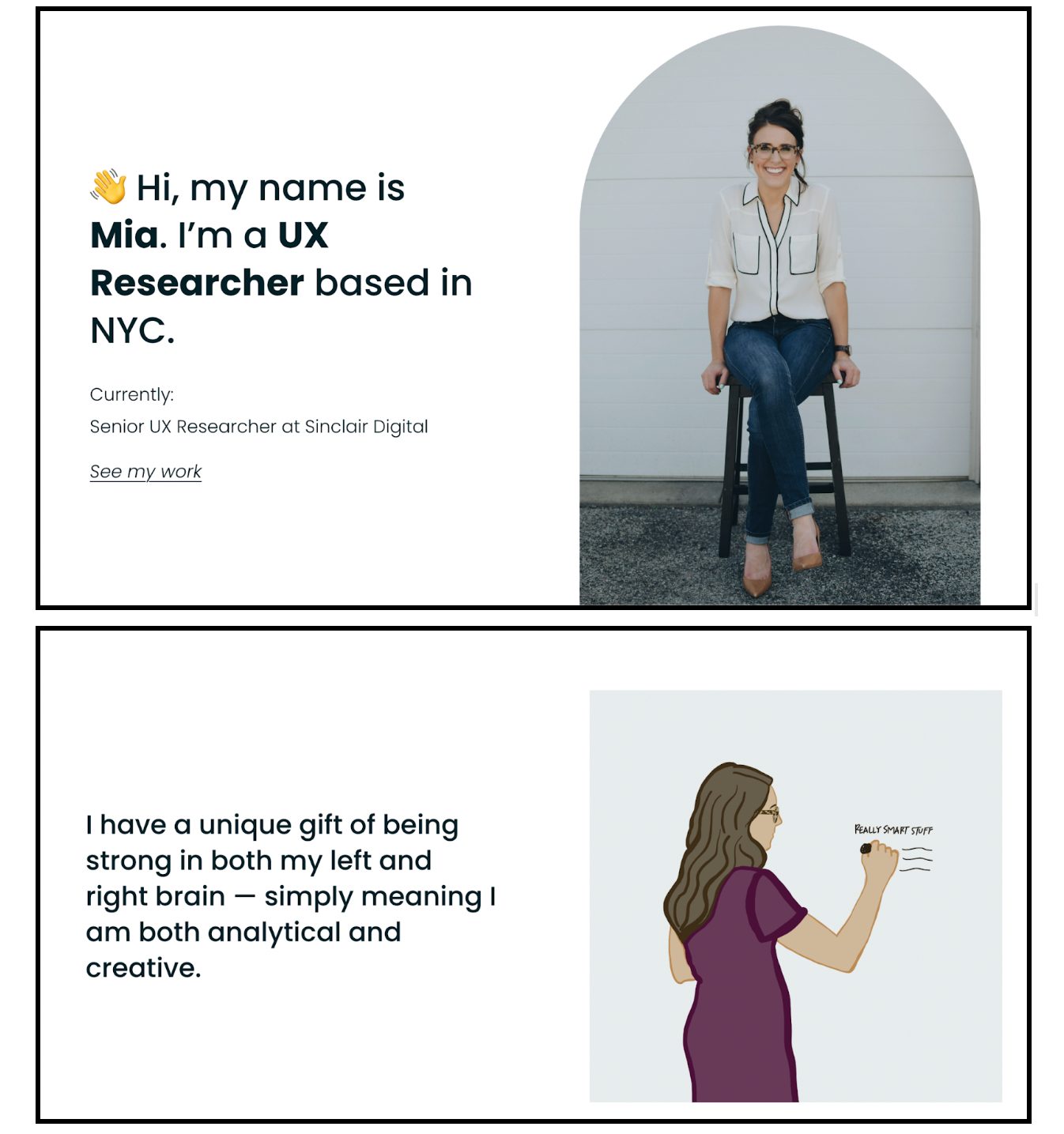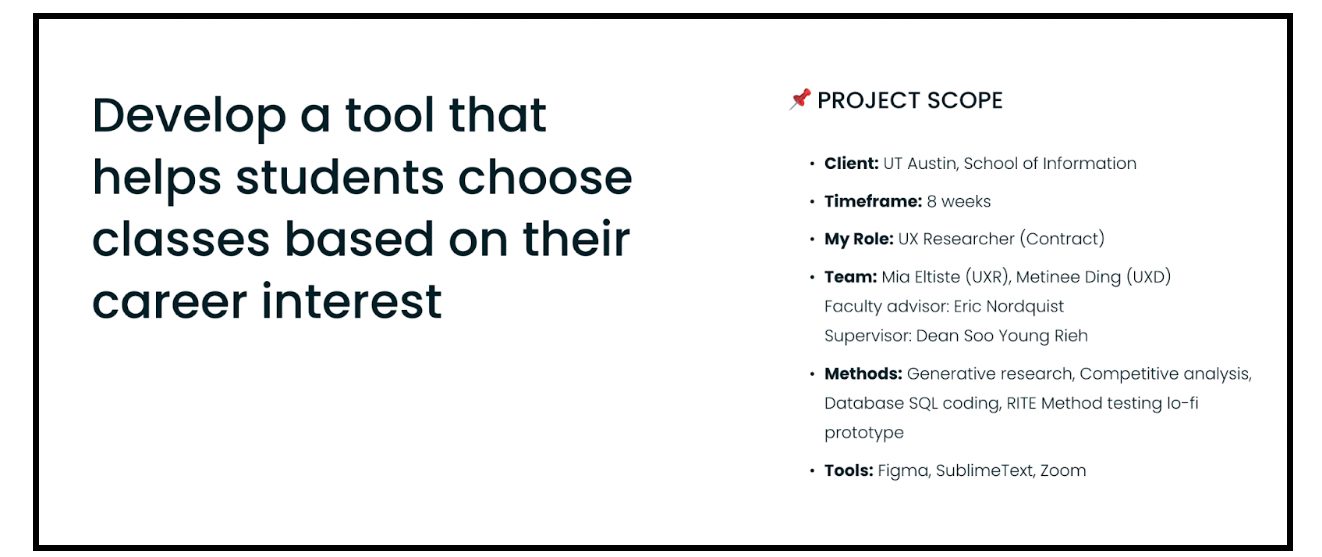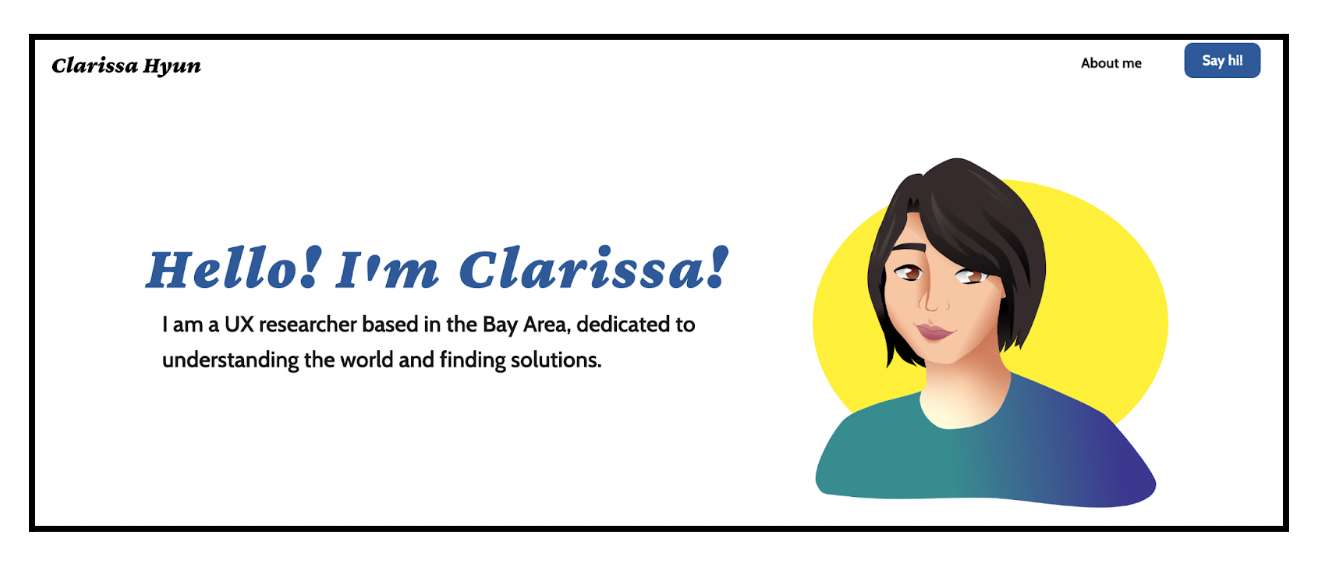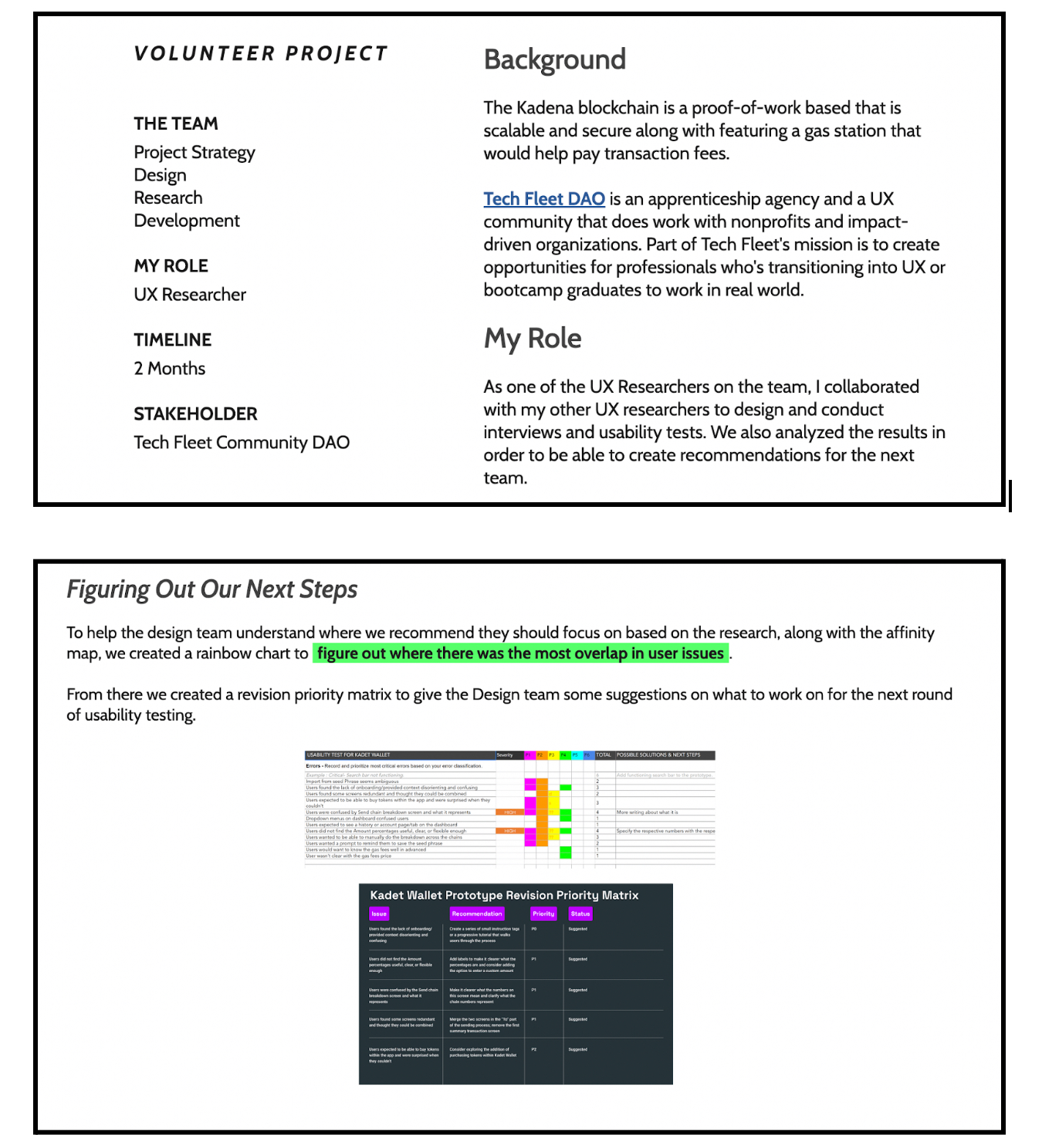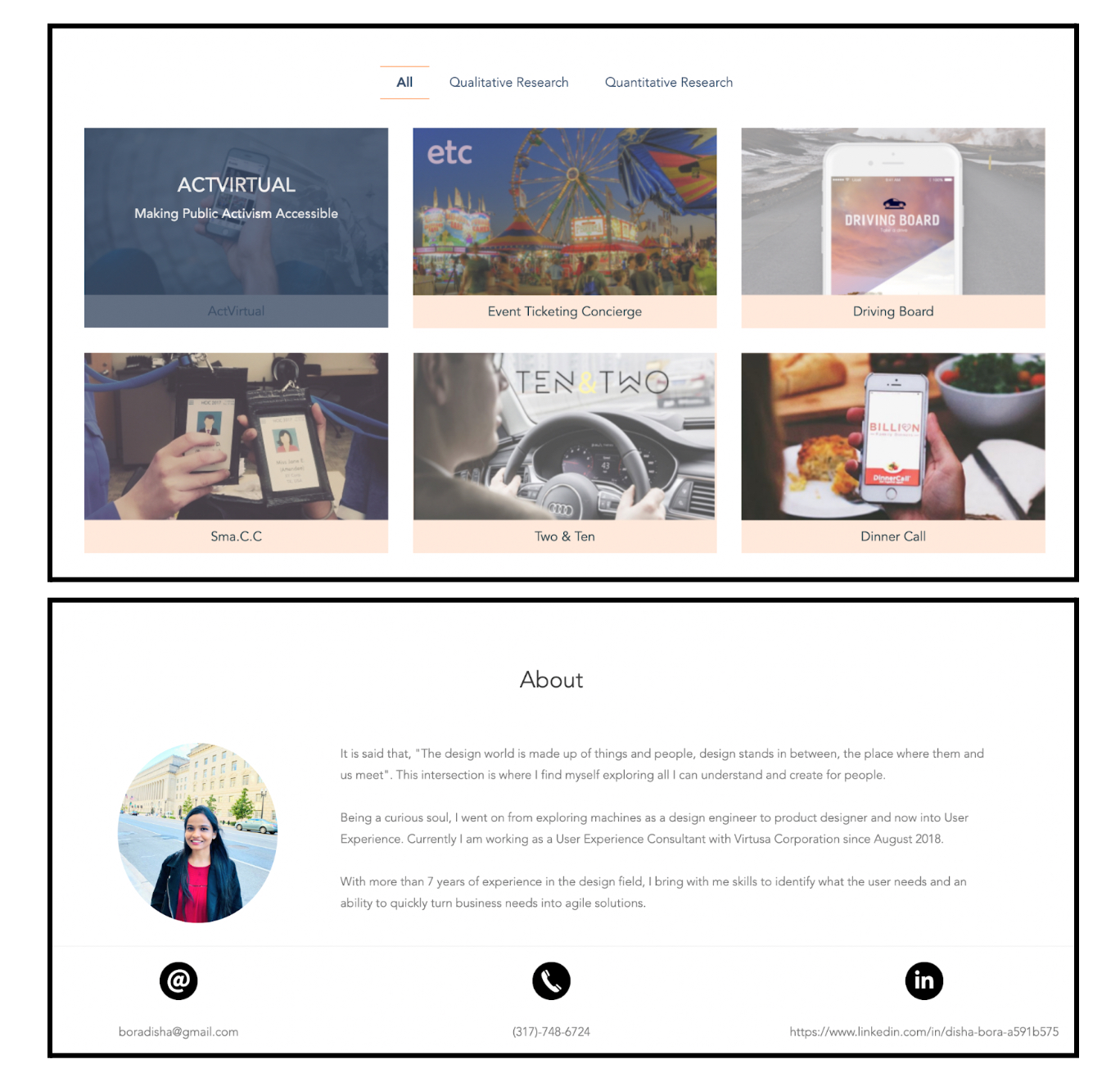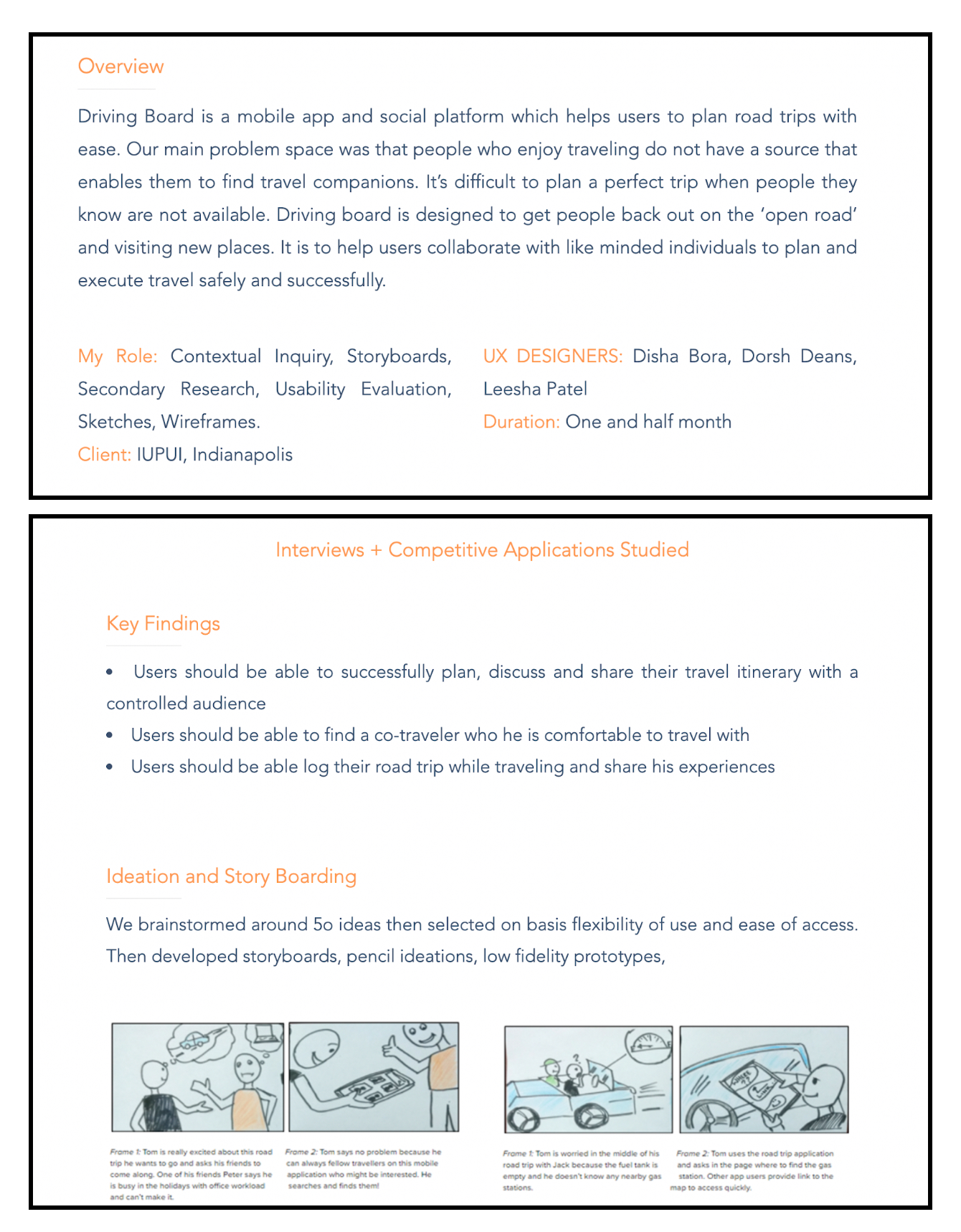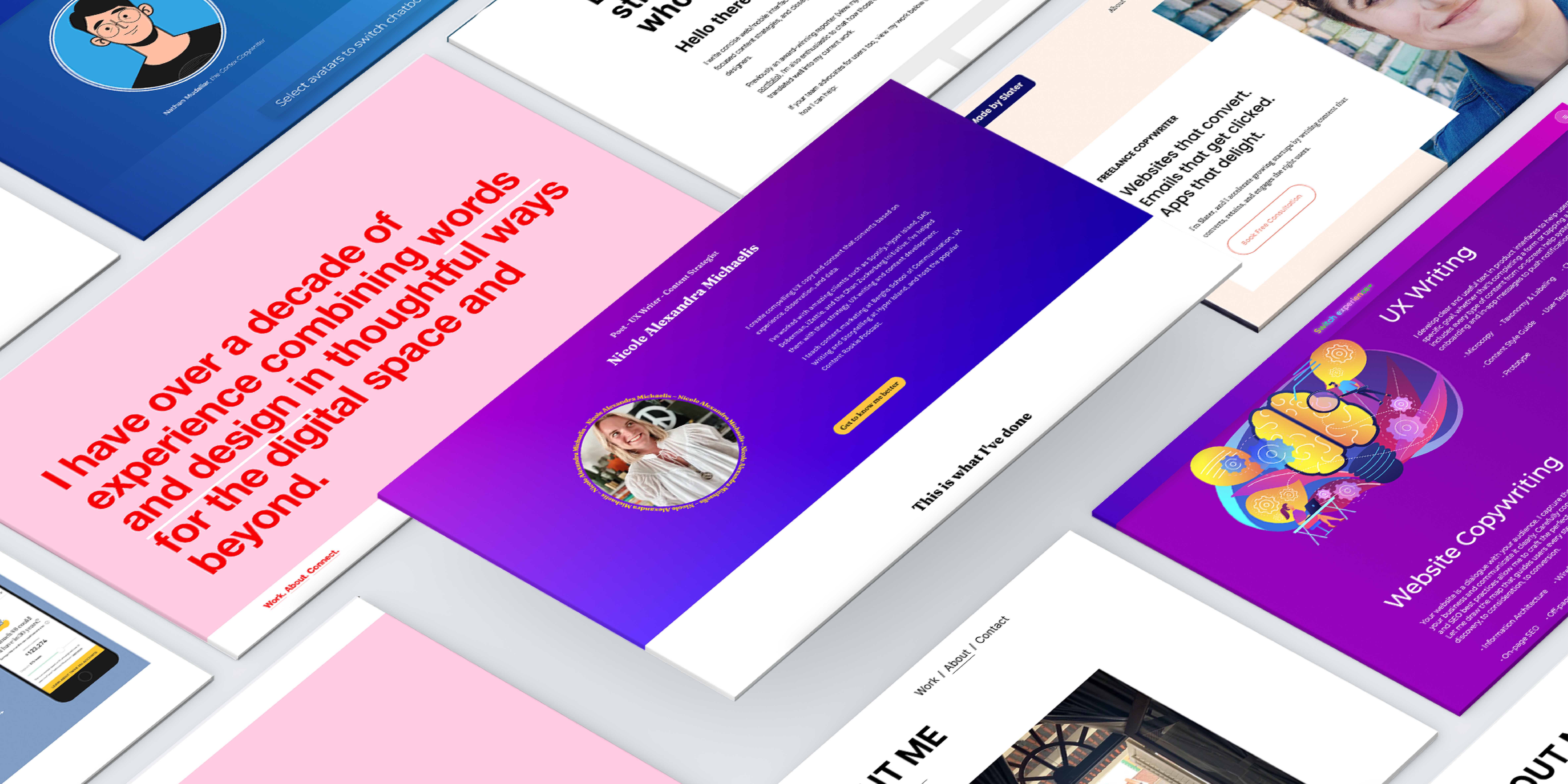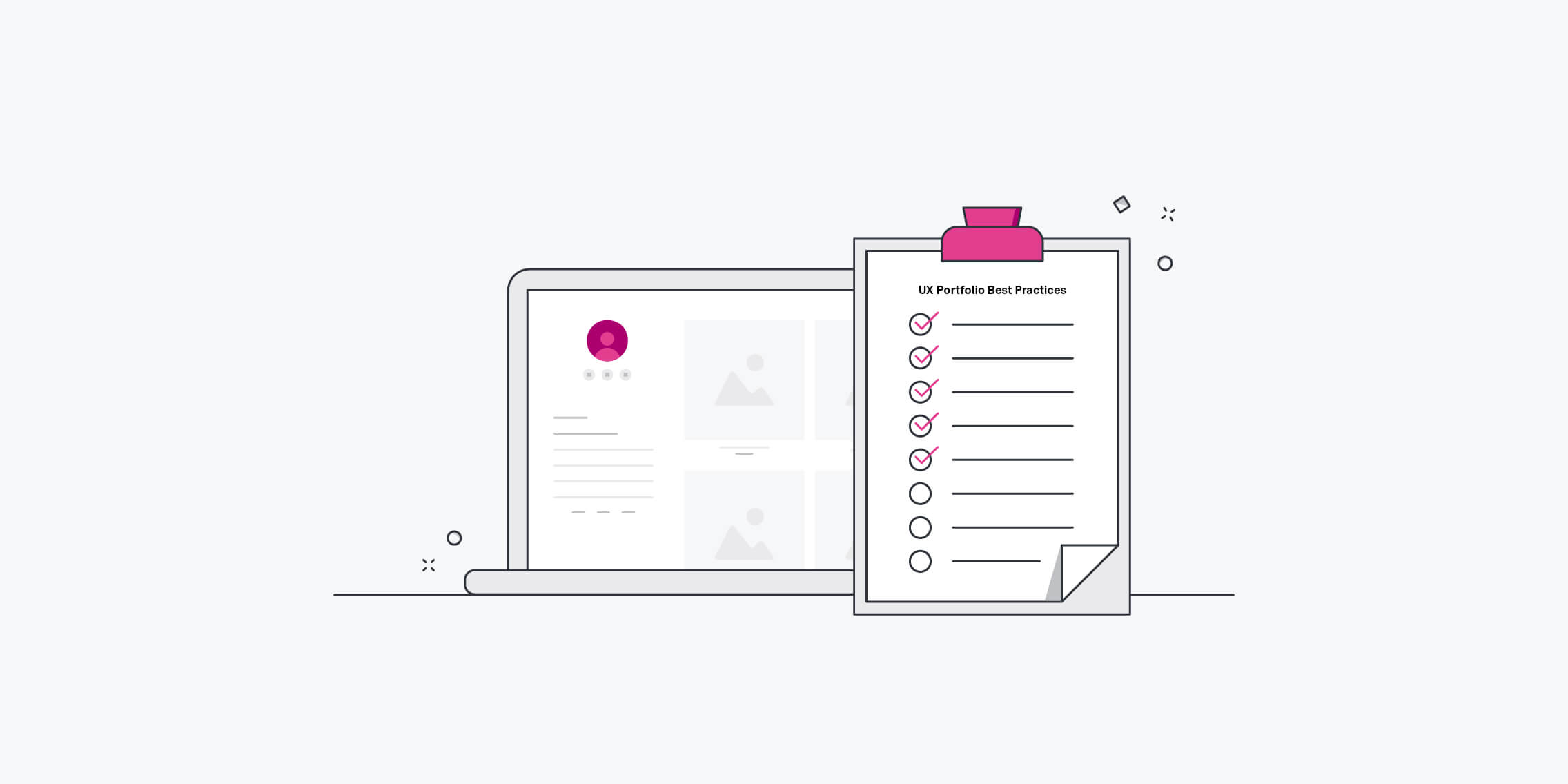It’s not just UX and UI designers who need a professional portfolio. UX researchers do, too. With a carefully crafted UX research portfolio, you can showcase your unique skills and expertise—positioning yourself as a strong candidate for UX research roles.
But, in the absence of prototypes and other visual artefacts, how do you create an impressive portfolio? Is it truly possible to capture and convey exactly what you do as a UX researcher?
Absolutely, and we’ll show you how in this guide. Keep reading to learn everything you need to know about creating an impressive UX research portfolio.
What is a UX research portfolio and why do you need one?
If you want to get hired as a UX researcher, you need a professional portfolio. It’s an industry-wide expectation—and likely the first thing an employer will look at if they’re considering you for a role.
A UX research portfolio is a carefully curated showcase of projects you’ve worked on. It’s specifically designed to highlight your skills and expertise as a UX researcher, providing insight into your methods, processes, and general approach to user research.
Usually, a UX research portfolio takes the form of a personal website, although some researchers opt for a simple presentation deck or PDF. Whichever format you choose, your portfolio has one main goal: to demonstrate that you’re a qualified UX researcher with a unique set of skills, qualities, and experience.
How is a UX research portfolio different from a UX design portfolio?
On the surface, UX design portfolios and UX research portfolios are rather similar. They typically follow the same format, and they both feature project case studies. However, they emphasise different skills and focus on different aspects of the design process.
A UX design portfolio showcases how UX designers get from ‘user problem’ to ‘effective solution.’ It highlights the creative and problem-solving aspects of design, following the UX designer’s journey from research and ideation to wireframes and prototypes.
A UX research portfolio, on the other hand, focuses on the UX researcher’s role in obtaining valuable user insights—and how those insights shape future design decisions.
With that in mind, let’s take a closer look at the skills you’ll want to highlight in your UX research portfolio.
What do hiring managers look for in a UX research portfolio?
When browsing your UX research portfolio, hiring managers want to see evidence of your UX research skills—and, most importantly, your ability to apply those skills to real-world projects and scenarios.
Your UX research portfolio should demonstrate:
- Proficiency in quantitative and qualitative research methodologies such as user interviews, surveys, usability tests, and card sorting exercises (to name a few).
- Data analysis skills. Showcase your ability to analyse and interpret research data and effectively communicate your findings.
- A user-centred approach that focuses on cultivating empathy and understanding users’ needs, goals, behaviours, and motivations.
- Communication and collaboration. Demonstrate that you’re able to work seamlessly with designers, developers, product managers, and other stakeholders to integrate research insights into the design process.
- An ethical approach to UX research, including awareness of potential risks and adherence to ethical best practices. You can learn more about user research ethics in this guide.
- Results and impact. Showcase how your research and insights directly impact the user experience and contribute to business success.
That’s not an exhaustive list, and you’ll want to tailor your UX research portfolio to reflect your own unique skill set—as well as the kinds of roles you want to apply for. However, that should give you an idea of the core skills to highlight.
What should you include in a UX research portfolio?
To effectively showcase your skills and develop a strong UX research portfolio, you’ll need:
- An ‘About’ page or section. This is where you introduce yourself to potential employers, providing a glimpse into your background, interests, and expertise. We recommend including a short ‘elevator pitch’ on your portfolio homepage and linking out to a more detailed introduction on a separate page. We’ll show you how to craft this content later on in our guide.
- 3-5 case studies. Your case studies are the star of the show—your moment to shine! Each case study should focus on a specific project where you contributed as a UX researcher. Outline your process, methodologies, findings, and the impact of your work, using both text and visual artefacts to document the project.
- Contact details. Make it easy for people to connect with you through your UX research portfolio. Include your email address or a contact form, as well as links to any relevant online profiles.
- A resumé-style list of your skills and experience (optional). While not essential, a resumé-style list of your skills, qualifications, and experience can provide a quick, easily skimmable overview of your credentials.
- Testimonials (optional). If you have them, testimonials from previous clients, colleagues, or mentors can add an extra touch of credibility to your UX research portfolio. If you don’t have any yet, don’t worry—you can always add them at a later date.
That’s the anatomy of a UX research portfolio. Now let’s explore how to create your own portfolio from scratch.
How to create a stand-out UX research portfolio (step-by-step)
Step 1: Define your audience and your personal brand
Before you create your UX research portfolio, it’s important to be clear on two things:
- Your personal brand: How do I want to market myself?
- Your target audience: Who do I want to market myself to?
Perhaps you’re a junior UX researcher looking for your first in-house role. Maybe you’re a freelancer who specialises in qualitative user research, or a seasoned UX researcher with expert knowledge of the finance sector.
Whatever your personal brand, you want to create a portfolio that accurately reflects your skills, goals, and passions. This, in turn, will position you as a strong candidate for the roles you’re truly interested in.
Defining your personal brand will naturally lead you to consider your target audience. If you’re a freelancer, for example, you’ll want to market yourself to certain types of clients. If you’re looking for UX research roles in the finance industry, you’ll want to appeal to employers within that space.
Once you know exactly how you want to position yourself, and the kinds of roles and employers you want to connect with, you’ll find it much easier to create a compelling portfolio.
Step 2: Choose a platform to host your portfolio website
Now for the practical matter of building your portfolio website. There’s no need to design and code your portfolio from scratch (unless you want to, of course); there are plenty of professional tools that offer customisable portfolio templates.
Popular options include Wix, Squarespace, and Webflow—to name just a few. We’ve rounded up the 10 best UX portfolio builders (and their pros and cons) in this guide. Browse through to find the most suitable option, considering factors like ease of use, customisation, and price.
Once you’ve settled on a platform, experiment with different templates to find the best design for your website. This will make it easier to plan the content for your portfolio, giving you a blueprint to work from.
Step 3: Write a strong bio
If you completed step one, you’ll already have a well-defined personal brand. Now you’re going to use it to craft a compelling bio.
Anyone viewing your UX research portfolio should get a clear sense of who you are, where your strengths lie, and what you’re passionate about when it comes to user research. That’s the purpose of your ‘about’ content; to convey your personal brand and connect with your target audience.
Start by crafting a short and sharp elevator pitch for your portfolio homepage. This is your hook. It should grab the reader’s attention and make them want to learn more about you.
Summarise, in one or two sentences, who you are and what you’re all about. For example:
“Hi! I’m Leela, Senior UX Researcher at ZenSpace. I’m passionate about decoding user behaviour to make mental health technology more accessible and engaging.”
Next, write a more expansive biography highlighting your most relevant skills, accomplishments, and experience. Aim for two or three short paragraphs, building a logical narrative from start to finish. You can place this section underneath your elevator pitch on the homepage, or on a separate ‘about’ page.
Step 4: Build out your UX research case studies
Each case study in your UX research portfolio should showcase a specific project you’ve worked on. To build your case studies, select 3-5 projects you’re most proud of—thinking back to the roles you want to qualify for and the skills you want to highlight.
For each case study:
- Provide context for the project. What did you set out to do? What questions were you seeking to answer? What were your key objectives?
- State what your role was (e.g. lead UX researcher)
- Describe the research methodologies you used, explaining why you chose those particular methodologies and how they supported the goals of the project
- Describe any challenges you encountered along the way and how you overcame them
- Present the key findings and insights derived from your research, supported by visual artefacts such as charts, graphs, or quotes
- Outline next steps. How did you translate your research findings into action points?
- Discuss the impact of your research, both from a user perspective and a business perspective. How did your work directly contribute to a better user experience? How did you contribute to the achievement of business goals?
As you develop your case studies, weave a logical narrative that the reader can follow. By the end, they should have a good understanding of how you work, make decisions, solve problems, and ultimately deliver impactful user experiences.
Step 5: Test, iterate, and publish
You’re almost there! Once you’re happy with how your portfolio is shaping up, prepare to launch it to the world.
But first: share it with a group of trusted friends, peers, or mentors for feedback. Does your UX research portfolio accurately capture your skills and expertise? Does it do a good job of conveying your personal brand? Is it easy to navigate? Is the content clear and reader-friendly? Do your case studies tell a logical story?
Based on their feedback, iterate on your UX research portfolio until you have a polished, fully-tested version that you can confidently share.
Ready? Go live! Hit publish, give it one final run-through, and promote it proudly on social media.
UX research portfolio best practices
Want to optimise your UX research portfolio and really impress hiring managers? Here are three additional best practices to bear in mind.
Showcase results and impact
When creating your UX research case studies, don’t fall into the trap of simply stating what you did, step by step.
Eoghain Cooper, Career Advisor and Recruiting Specialist at UX Design Institute, emphasises the importance of showcasing the impact of your work:
“Often, when starting their portfolio, junior designers will explain what they did, step-by-step, without actually highlighting the impact of their work. However, hiring managers don’t necessarily need to see affinity diagrams—they need to see what key insights you took from them and how you utilised them.
For example, I would usually recommend that someone highlight their research strategy and explain why they’ve chosen particular methods and how that supports the project. I also want to see the key results that came from that, and how those were balanced against business considerations—not just the needs of the end user. From there, I want to see what decisions they made and the impact of those decisions. A hiring manager is going to be looking for results and impact.”
How did your insights improve the user experience? What impact did your research have on the business? Do you have any quantifiable metrics you can share?
Highlight the outcomes of your research; that’s how hiring managers will know that you’re a skilled UX researcher.
Make sure your portfolio is user-friendly and accessible
Your UX research portfolio must provide a positive user experience. Make sure it’s easy to navigate, mobile-friendly, and accessible to a wide audience, including those with disabilities. Pay attention to your content, too. Use clear, jargon-free language and break content up into short, skimmable paragraphs.
Review and update your UX research portfolio on a regular basis
Your UX research portfolio should evolve in line with your skills and experience. As you progress through your career, keep your portfolio relevant and up-to-date. Don’t wait until you’re applying for a new job; review your portfolio periodically and make sure it accurately reflects your personal brand right now.
UX research portfolio examples to inspire you
Looking for an extra dose of inspiration? Here are some great UX research portfolio examples.
Mia Eltiste’s UX research portfolio
Mia Eltiste is a senior UX researcher with a background in information studies and psychology. Her UX research portfolio is a masterclass in clean, user-friendly design and strong personal branding. Take inspiration from her powerful elevator pitch, compelling ‘About’ page, and flawlessly structured case studies.
Clarissa Hyun’s UX research portfolio
Clarissa Hyun is a UX researcher “dedicated to understanding the world and finding solutions.” Clarissa’s portfolio does a great job of showcasing her professional expertise and telling the story of how she discovered her passion for UX research. Her case studies are excellent, too, comprising a good balance between text and visuals.
Disha Bora’s UX research portfolio
Disha Bora is a senior UX researcher, skilled in both qualitative and quantitative research methodologies. Her portfolio does an excellent job of showcasing her diverse skill set—and it’s incredibly user-friendly. You’ll find all key information right there on the home page, including a wide selection of case studies, her resumé (also available to download as a PDF), a concise bio, and contact links. Disha’s UX research portfolio is simple yet impactful, conveying her professionalism and expertise.
UX research portfolio FAQs
Do UX researchers need a portfolio?
Yes—in fact, anyone working in the UX industry (or aspiring to do so) needs a professional portfolio. A UX research portfolio showcases your skills, methodologies, and impact. It shows employers that you’re qualified for UX researcher roles, and it’s one of the first things a hiring manager will look at.
How do I create a UX research portfolio with no experience?
You can still create an effective UX research portfolio, even if you don’t have any real-world experience. Include personal projects, freelance work, internships, or projects you’ve worked on as part of a UX research course. At the same time, emphasise your passion for UX research, your willingness to learn, and transferable skills such as critical thinking, communication, and problem-solving.
How do I start a UX research portfolio?
Start by thinking about your personal brand and how you want to position yourself within the UX research job market. Then gather 3-5 research projects you’re especially proud of, and that accurately convey your skills and expertise. These will form your portfolio case studies.
The takeaway
A strong UX research portfolio demonstrates your skills and expertise as a UX researcher. It shows prospective employers and clients what you’re capable of, providing proof in the form of detailed case studies. This helps you to stand out in your field, build a memorable personal brand, and position yourself as a strong candidate for UX research roles.
If you’re new to UX research and not quite ready to create your portfolio, consider UX Design Institute’s Professional Certificate in User Research. Over the course of 16 weeks, you’ll learn how to conduct and analyse both quantitative and qualitative user research, using a variety of methodologies and tools. At the end of the program, you’ll complete a portfolio project—an excellent starting point for your UX research portfolio.
Want more UX research tips and industry insights? Check out these guides:
- How to find UX research jobs in 2024
- 3 real-world UX research case studies from Airbnb, Spotify, and Google—and what we can learn from them
- The 10 best UX research tools to add to your stack



